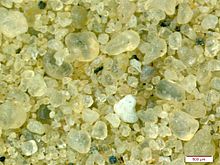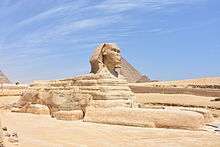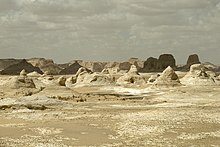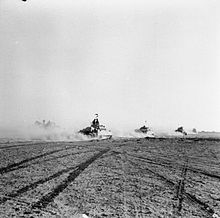Western Desert
Western Desert
الصحراء الغربية | |
|---|---|
| Country | Egypt |
InEgypt,theWestern Desertis an area of theSaharathat lies west of the riverNile,up to theLibyan border,and south from theMediterranean Seato theborder with Sudan.It is named in contrast to theEastern Desertwhich extends east from the Nile to theRed Sea.The Western Desert is mostlyrocky desert,though an area ofsandy desert,known as theGreat Sand Sea,lies to the west against the Libyan border. The desert covers an area of 680,650 km2(262,800 sq mi) which is two-thirds of the land area of the country.[1]Its highest elevation is 1,000 m (3,300 ft) in theGilf Kebirplateau to the far south-west of the country, on the Egypt-Sudan-Libya border. The Western Desert is barren and uninhabited save for a chain ofoaseswhich extend in an arc fromSiwa,in the north-west, toKhargain the south. It has been the scene of conflict in modern times, particularly during theSecond World War.

Administratively the Western Desert is divided between various governorates; in the north and west, theMatrouh Governorateadministers the area from the Mediterranean south to approx 27°40' N latitude, and theNew Valley Governoratefrom there to the Sudan border, while in the east parts of the Western Desert lie in theGiza,Fayyum,Beni Suef,andMinya Governorates.
Geography
[edit]The region is described by one writer as "a plateau standing on average some 500 feet [150 m] above sea level, barren, rubble- and boulder-strewn, dark brown in colour, occasionally dotted with scrub, and, at first sight, flat".[2]He also states that little of the area conforms to "the romantic view... the Hollywood scenery of wind-formed dunes with occasional oases fringed with palm"[2](although such areas do exist in the Sand Sea where dunes are sculpted into fantastic shapes); the area is also the location of a series of oases created where the land dips sufficiently to meet the aquifer. These lie in an arc fromSiwain the north-west near the Libyan border, toBahariya,Farafra,Dakhla,thenKhargain the south. East of Siwa lies theQattara Depression,a low-lying area dotted withsalt marshand extending 310 km (190 mi) west to east and 135 km (84 mi) north to south.[3]Further to the east, near the Nile, another depression gives rise to theFayyum Oasis,a heavily populated area separate from the main Nile valley.
To the south, beyond the Bahariya oasis lies theBlack Desert,an area of black volcanic hills anddoleritedeposits. Beyond this, north of Farafra, lies theWhite Desert,an area of wind-sculptedchalk rockformations, which give the area its name. To the south of Kharga the plateau rises towards the Gilf Kebir, an upland region lying astride the Egypt-Sudan border and home to pre-historic sites such as theCave of Swimmers.
In the south-west, near the point where the borders of Libya, Sudan and Egypt meet, is an area ofdesert glass,thought to have been formed by a meteorite strike atKebira,over the border in Libya.
TheGreat Sand Seais a roughly lung-shaped area of sandy desert lying astride the border with Libya, 320 km (200 mi) inland from the Mediterranean. The sea is divided by a long peninsula of rocky desert along the border, leaving the eastern lobe in Egypt and the western in Libya, where it is called the Calanshio desert. On the Egyptian side it was known historically as the "Libyan Desert", taking its name fromAncient Libya,which lay between the Nile and Cyrenaica. With the formation of the state ofLibya,the term "Western Desert" has come to describe the part of the Sahara in Egypt.
Boundaries
[edit]To the Ancient Greeks, the term Libya described the whole Saharanlittoralwest of the Nile to theAtlas Mountains. In Roman times, the term Libya was limited to Cyrenaica and the region between there and Egypt, organized as the provinces of Libya Superior and Libya Inferior. The term Libyan Desert then applied to the area to the south of these provinces. This became a misnomer during colonial times when Cyrenaica and the land to the west was organized as theItalian colony of Libyain 1911, and the term Western Desert used to describe the area within Egypt became more common.
Playfair described the Western Desert of 1940 as 390 km (240 mi) wide (i.e. from the Nile to the Libyan border) and 240 km (150 mi) from the Mediterranean to the latitude ofSiwa Oasis,while the region to the south was referred to as the Inner Desert.[4] However, during the Second World War the term Western Desert came to apply not only to the coastal desert of Egypt but also to the area fought over in Libya, ranging beyond the Egypt-Libya border toGazala,Cyrenaicaand evenEl Agheila.
The contemporary use of the term refers to the entire desert in Egypt west of the Nile.[1][5]
List of Deserts
[edit]Giza Plateau
[edit]
TheGiza Plateau(هضبة الجيزة) is aplateauin Giza, on the outskirts ofCairo,Egypt, at the edges of the Western Desert, site of theFourth DynastyGiza Necropolis,which includes the Great Pyramids ofKhufu,KhafreandMenkaure,theGreat Sphinx,several cemeteries, a workers' village and an industrial complex.

TheGiza pyramid complex(مجمع أهرامات الجيزة), also called theGiza necropolisand also known as thePyramids of GizaorEgypt,is the site on theGiza Plateauin Giza andGreater Cairo,Egypt that includes theGreat Pyramid of Giza,thePyramid of Khafre,and thePyramid of Menkaure,along with their associated pyramid complexes and theGreat Sphinx of Giza.All were built during theFourth Dynastyof theOld KingdomofAncient Egypt,between 2600 and 2500 BC. The site also includes several cemeteries and the remains of a workers' village.
The Giza pyramid complex consists of theGreat Pyramid(also known as the Pyramid of Cheops orKhufuand constructed c. 2580 – c. 2560 BC), the somewhat smallerPyramid of Khafre(or Chephren) a few hundred metres to the south-west, and the relatively modest-sizedPyramid of Menkaure(or Mykerinos) a few hundred metres farther south-west. TheGreat Sphinxlies on the east side of the complex. Current consensus among Egyptologists is that the head of the Great Sphinx is that ofKhafre.Along with these major monuments are a number of smaller satellite edifices, known as "queens" pyramids, causeways and valley pyramids.

TheGreat Sphinx of Gizais alimestonestatue of a recliningsphinx,amythical creaturewith the head of a human, and the body of a lion. Facing directly from west to east, it stands on the Giza Plateau on the west bank of the Nile in Giza, Egypt. The face of the Sphinx appears to represent thepharaohKhafre.
The original shape of the Sphinx was cut from thebedrock,and has since been restored with layers oflimestone blocks.It measures 73 m (240 ft) long from paw to tail, 20 m (66 ft) high from the base to the top of the head and 19 m (62 ft) wide at its rear haunches. Its nose was broken off for unknown reasons between the 3rd and 10th centuries AD.
The Sphinx is the oldest knownmonumental sculpturein Egypt and one of the most recognisable statues in the world. The archaeological evidence suggests that it was created by ancient Egyptians of theOld Kingdomduring the reign of Khafre (c. 2558–2532 BC).
Great Sand Sea
[edit]
TheGreat Sand Seais a desert in the Sahara between western Egypt and eastern Libya inNorth Africa,74% of the area is covered by sand dunes.
The Great Sand Sea stretches about 650 km (400 mi) from north to south and 300 km (190 mi) from east to west. On satellite images this desert shows a pattern of long sand ridges running in a roughly north–south direction. However, despite the apparent uniformity the Great Sand Sea has two large areas with different types of megadunes. The Egyptian sand sea lies parallel to theCalanshio Sand Seaof Libya, with which it is contiguous in the north. Thedunesof the Great Sand Sea cover about 10% of the total area of the Western Desert.
Black Desert
[edit]
TheBlack Desert(الصحراء السوداء) is a region of volcano-shaped and widely spaced mounds, distributed along about 30 km (19 mi) in the Western Desert between the White Desert in the south and theBahariya Oasisin the north. Most of its mounds are capped by basalt sills, giving them the characteristic black color.
The mounds of the Black Desert, up to 100 metres (330 feet) high, vary in size, composition, height, and shape as some are dark consisting of ironquartzitewhile others are more reddish as its surface rocks consist of iron sandstone. On the outskirts of the Black Desert are volcanic hills proving the eruption of dark volcanicdolerite,dating back to theJurassicperiod 180 million years ago.
White Desert
[edit]
TheWhite Desertis anational park,first established as a protected area in 2002. It is located in theFarafra depression,45 km (28 mi) north of the town ofQsar El Farafra.Part of the park is in the Farafra Oasis (New Valley Governorate).
The park is the site of large whitechalkrock formations, created through erosion by wind and sand. It is also the site of cliffs (at the northern end of the Farafra Depression), sand dunes (part of the Great Sand Sea), as well asWadi Hennisand oases atAin El MaqfiandAin El Wadi.
The park serves as the refuge for various animals, including the endangeredRhim gazelleand the vulnerableDorcas gazelle,as well asBarbary sheep;jackals;Rüppell's,redandfennecfoxes; and thesand cat.
History
[edit]
In pre-historic times the Western desert is thought to have been a semi-aridgrassland,home tosavannaanimals andhunter-gatherers;evidence of abundant wildlife can be found in the cave paintings of the Gilf Kebir. It is thought that over-grazing and climate change led todesertificationand the current geography. Even after this, however, the oases remained inhabited, and the Antiquities Museum at Kharga has artifacts dating back to times before the early Egyptian kingdoms.
In ancient times the area was regarded as being under the jurisdiction of the kingdom of Egypt, and Egyptian remains can be found in all the oases. In 525 BC, theLost Army of Cambyses,a military expedition by the Persian kingCambyses IIgot lost in the desert while searching for theOracle of Ammon,at Siwa. In 333 the Oracle of Ammon was visited byAlexander the Great,where he was confirmed as the son ofAmun.
With the absorption of the kingdom of Egypt into the Roman Empire, the desert region was organized into the province of Libya Inferior, while Cyrenaica became Libya Superior. In time the region came under the jurisdiction of the Byzantines and their successors, the Arabs, Mamluks and Turks. In 1882 the kingdom of Egypt became a British protectorate, and in 1912 the territory to the east was claimed by Italy as the colony of Libya.

In the 20th century the Western Desert became an arena of conflict; during theFirst World Warit was the location of theSenussi Campaignagainst the British and Italians. The 1930s saw an upsurge of exploration and mapping expeditions by British Army officers, such asRalph BagnoldandPat Clayton,laying the basis for war-time operations by such forces as theLong Range Desert Group.This period was also marked by the search forZerzura,a mythical oasis in the deep desert. During theSecond World War,from June 1940 until November 1942, it was the location of theWestern Desert Campaignfought between the Axis powers (Italy and Germany) and the Western Allies (principally Britain and Commonwealth countries, a total of 15 nations) until the Allied victory in November 1942.[6][7][8]
In modern times the Egyptian government has encouraged settlements in the oases, and surveyed for minerals, particularly oil.
Western Desert - "Toshka Project"
[edit]In October 2020, PresidentAbdul Fattah el-Sisi ordered the revival of an ambitious decades old agricultural project once named theToshka Project(aka the New Valley Project), aimed at creating a new delta in the middle of Western Desert and increasing living space and prosperity for Egypt's growing population.[9]President El-Sisi specified that 6.4 billion Egyptian pounds ($413 million) would be needed for the necessary infrastructure, breathing new life into national hopes for turning the desert green. Originally, Project Toshka was spear-headed by former PresidentHosni Mubarak,who spent 40 billion Egyptian pounds on the project, establishing the necessary electricity plants and water pumping stations.[10]A few years later, however, the project came to a sudden halt, with failure being attributed to the lack of political will and necessary investments.[9]
Notes
[edit]- ^abWestern DesertatEncyclopædia Britannica
- ^abPitt p13
- ^Fouad N. Ibrahim; Barbara Ibrahim (5 December 2003).Egypt: An Economic Geography.I.B.Tauris. pp. 57–.ISBN978-1-86064-548-8.
- ^Playfair pp115-117
- ^Western Desertat countrystudies.us (Library of Congress)
- ^Firestone pp320-367
- ^Sattin pp267-293
- ^Thompson, Folkard pp252-263
- ^ab"Egypt revives Western Desert agricultural project - Al-Monitor: The Pulse of the Middle East".www.al-monitor.com.Retrieved2022-01-06.
- ^"Mubarak: Toshka Project Opens Way Towards New Civilization In Egypt".american_almanac.tripod.com.Retrieved2022-01-06.
References
[edit]- Firestone:Egypt(10th ed 2010) Lonely PlanetISBN978-1-74179-314-7
- McLachlan:Egypt(3rd ed 2000) Footprint GuidesISBN1 900949 68 7
- Pitt:The Crucible of war: Western Desert 1941(1980) Jonathan CapeISBN0 224 01771 3
- Playfair:War in the Mediterranean vol I(1956) HMSO ISBN (none)
- Sattin:Discover Egypt(2nd ed 2012) Lonely PlanetISBN978-1-74220-224-2
- Thompson, Folkard:EgyptDorling Kindersley (2001; reprint 2011)ISBN978 1 4053 5787 6







